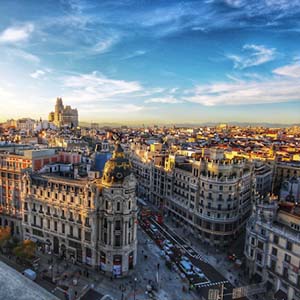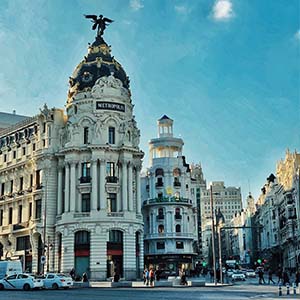Moving to Madrid
With a warm climate, fantastic nightlife, and some stunning architecture, it’s easy to see why so many people relocate to Madrid. While Madrid is a relatively new addition to Europe’s capital cities, it has played a part in Spanish history since its capture by Christians in 1085 from the Moors. As one of the largest cities in Europe, in modern years it has developed into a hub for high-end technology and the finance sector.
The 18 districts, or barrios, are home to around 3.2 million people, with around 13% of this number being immigrants. The government and business areas are situated to the north of the Paseo de la Castellana, whereas the most desirable districts to live in are in the northern and eastern areas of the city.
What is the weather like in Madrid?
The Mediterranean climate may be a welcome change for people moving to Madrid from the UK. Compared to London, people living in Madrid will experience approximately 87% more sunshine hours a year and temperatures in summer often rise over 30C. When the heat gets too much, the Manzanares River helps cool down the surrounding areas.

Things to do in Madrid
Have you recently moved to Madrid? Spend your weekends exploring this beautiful city and all it has to offer. Head over to Retiro park for a picnic, immerse yourself in history in the Royal Palace or watch a football game in Santiago Bernabeu Stadium.
Learning the Language
Like many places, when moving to Madrid learning the local language will highly improve your assimilation into your new surroundings. The official language of Madrid is Castellano, or Castilian, and is spoken widely throughout Spain. In Madrid, there are plenty of tutors and schools that can help you to begin picking up the language and being surrounded by it every day will be great practice. The learning can even start before you go, in classes or using online apps and websites.
As this is part of the assimilation process, we can even help with the language. Our Employee Relocation Services ensure that you can settle into your new home as fast as possible.
Public Transportation in Madrid
Public transport in Madrid is well established and varied in type, making life in Madrid quick and easy to navigate. Madrid’s metro system is a fast, clean, and efficient way to get around the majority of the city, with around 200 stations on 13 different lines. Madrid’s buses are also a great way to get around above ground with 170 bus lines across the city, and the suburbs are connected to the city centre by the Cercanias railway. While you can buy individual tickets for your journeys, there are monthly and annual passes that will save time and money if you are to use public transport more frequently. Connections to the airport, as well as taxis, are also well established.
Due to the well-developed nature of the public transport system and the provision of cycle paths, many people living in the city feel no need for their own vehicle. Parking is also difficult to come by in the city centre, so it’s mainly people living in Madrid’s suburbs that drive cars in the city.

Where to live in Madrid
Life in Madrid can differ hugely depending on which barrio you choose. Like any city, there are advantages and disadvantages to living in different areas of the city. If you live in the inner city, you will benefit from a short commute to work and from enjoying walking through the more traditional areas of the city. You will, however, need to put up with the traffic, noise and pollution of a capital city centre.
If you choose to live in a suburb, you will escape the worst of the traffic but be faced with longer commutes into the finance and business sectors for work. Along with greener spaces and cleaner air, bus stops and metro stations are also plentiful in suburban neighbourhoods. The barrio which you choose, if moving to Madrid with your family, might be swayed by the location of nearby schools. Popular areas with expatriates are as follows.
Central Madrid
Mirasierra – Situated on the northern boundary of the city, Mirasierra is a 15-minute metro ride or a 30-minute bus ride away from the city centre. There is a range of housing available, from apartments to detached houses, and good entertainment and shopping facilities are nearby. Residents here are also close to a large international hospital and 20km from the American School.
Parque del Conde Orgaz – This is one of the most desirable barrios in the Madrid area and offers a good combination of city living and suburban facilities. Just 7km from central Madrid, 15-30 minutes by bus, housing here can be difficult to find. This area is popular with French families, who tend to pass houses to other French people.
Northern Madrid
Cuidalcamp and Santo Domingo – These areas straddle the Burgos Highway, around a 30-minute drive north of the city centre. There is a good amount of affordable detached houses, and the areas are also close to most European schools in Madrid. There are good entertainment and shopping facilities nearby.
Fuente del Fresno – Even further north, around 20-40 minutes by car, this barrio allows for a slower-paced and quiet neighbourhood while not venturing too far from the city. There is a range of attractive apartments and houses in this area and hourly bus connections to the centre of Madrid.
La Moraleja – Also 20-40 minutes north of the city centre, La Moraleja benefits especially from great access to the international airport. It is popular among Europeans due to the excellent nearby foreign schools, including the British Runnymede College. There is a variety of housing options, many with a garden, pool, and garages. Despite heavy morning traffic, bus routes provide a 15-20-minute journey to the centre of town. There are large supermarkets, churches, and sports facilities nearby.

Western Madrid
Las Rozas – The reasonable prices of townhouses and apartments in this quiet neighbourhood mean that housing here is highly sought after by expatriates. Though traffic means that the drive to the city centre varies between 20 and 75 minutes, there are bus and train connections to the city too. There is a good selection of shops and restaurants as well as good sports facilities, and the bilingual Kensington School is nearby too.
Social Life and Entertainment
The size of Madrid and the variation in neighbourhood culture means that there is rarely a dull moment. There is a huge culture of dining out in Madrid, with excellent establishments to choose from. There are countless clubs, restaurants, bars, cafes, and tapas bars for you to enjoy with other expats or with Spanish friends. If moving to Madrid or anywhere in Spain, you should be aware that meals are typically enjoyed later in the day, and nights out can begin at midnight and continue to 6 am.
In the daytime, there are many museums, galleries, and other entertainment facilities. Madrid is known for its art museums as the cultural centre of the country, and it’s home to the world’s most visited museum in the world – Museo del Prado in Madrid’s ‘Golden Triangle of Art’. Life in Madrid is also not all museums and galleries: Green spaces around the city, just like we find in London, also provide great spaces for friends to sit, walk and chat throughout the day. Find out more about Madrid’s attractions.
There are many clubs for different interests that will help you to make friends in the city. Clubs dedicated to every possible interest, whether sports, music or art, are to be found in Madrid. The International Newcomers Club of Madrid is an English-speaking organisation that has been helping new arrivals settle into their new home for over 30 years. If you are moving to Madrid from the UK, this could be a great place to meet other expats and acclimate to your new surroundings.
To find out more about how we can help you and your employees before, during and after an international relocation, check out our Relocation Management Services.

Interested in information on another country? Take a look at our other International Relocation guides.
Great customer Experiences start here
Very pleasent and helpful. Nothing too much trouble.
Mr M H moved from London, UK to Toronto, Canada
Very helpful and patient even when things got packed that we had to get out again!
Mr M E moved from Enfield, UK to Dorset, UK
Thanks to Graham, Nick and the entire crew!
Mr C D M moved from UK to Singapore
Friendly and helpful crew.
Ms T W moved from USA to Cambridgeshire, UK
